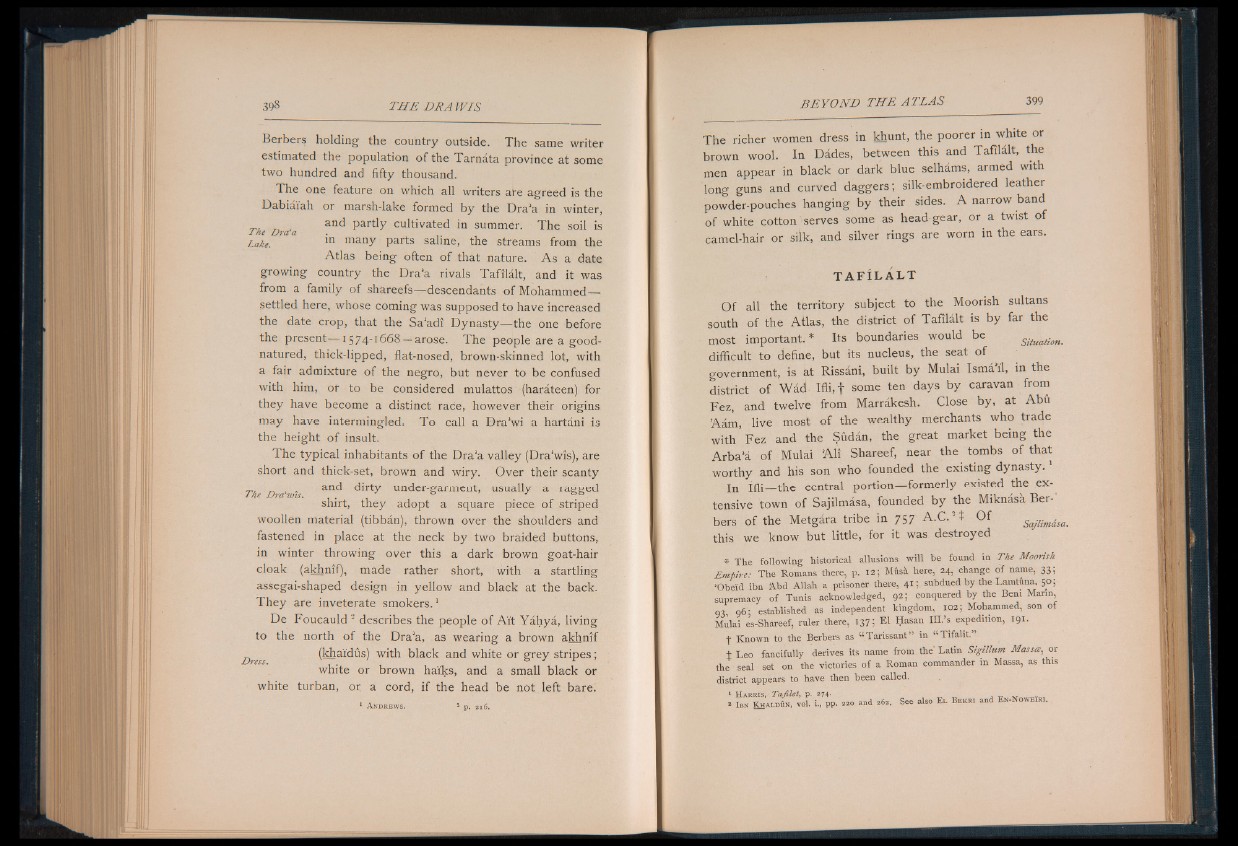
398 THE DR A WIS
Berbers holding the country outside. The same writer
estimated the population of the Tarnata province at some
two hundred and fifty thousand.
The one feature on which all writers ate agreed is the
Dabiai'ah or marsh-lake formed by the Dra’a in winter,
_ i and partly cultivated 1 he Dr a a in summer. The soil is
Lake. in many parts saline, the streams from the
Atlas being often of that nature. A s a date
growing country the Dra’a rivals Tafilalt, and it was
from a family of shareefs— descendants of Mohammed—
settled here, whose coming was supposed to have increased
the date crop, that the Sa'adi Dynasty— the one before
the present— 1574-1668-^ arose. The people are a good-
natured, thick-lipped, flat-nosed, brown-skinned lot, with
a fair admixture of the negro, but never to be confused
with him, of to be considered mulattos (harateen) for
they have become a distinct race, however their origins
may have intermingled. To call a Dra'wi a hartani is
the height o f insult.
The typical inhabitants of the Dra‘a valley (Dra‘wis), are
short and thick-set, brown and wiry. Over their scanty
and dirty under-garment, usually a ragged The Drawn. s s
shirt, they adopt a square piece of striped
woollen material (tibban), thrown over the shoulders and
fastened in place at the neck by two braided buttons,
in winter throwing over this a dark brown goat-hair
cloak (akhmf), made rather short, with a startling
assegai-shaped design in yellow and black at the back.
They are inveterate smokers.1
De Foucauld 2 describes the people of Ait Yahya, living
to the north of the Dra'a, as wearing a brown akhnif
(khaidus) with black and white or grey stripes;
white or brown haiks, and a small black or
white turban, or a cord, if the head be not left bare.
BEYOND THE ATLAS 399
The richer women dress in khunt, the poorer in white or
brown wool. In Dades, between this and Tafilalt, the
men appear in black or dark blue selhams, armed with
long guns and curved daggers; silk-embroidered leather
powder-pouches hanging by their sides. A narrow band
of white cotton' serves some as head gear, or a twist of
camel-hair or silk, and silver rings are worn in the ears.
T A F lL A L T
Of all the territory subject to the Moorish sultans
south of the Atlas, the district of Tafilalt is by far the
most important. * Its boundaries would be situation.
difficult to define, but its nucleus, the seat of
government, is at Rissani, built by Mulai Isma'il, in the
district of Wad I fli,f some ten days by caravan from
Fez, and twelve from Marrakesh. Close by, at Abu
Aam, live most of the wealthy merchants who trade
with’ Fez and the Sudan, the great market being the
Arba'a of Mulai A ll Shareef, near the tombs of that
worthy and his son who founded the existing dynasty.1
In Ifli— the central portion— formerly existed the extensive
town of Sajilmasa, founded by the Miknasa Berbers
of the Metgara tribe in 757 A .CA t O f Sajlimdsa.
this we know but little, for it was destroyed
* The following historical allusions will be found in The Moorish
Empire: The Romans there, p. 12; M&sa here, 24, change of name, 33;
‘Obeid ibn Abd Allah a prisoner there, 41; subdued by the Lamtuna, 50;
supremacy of Tunis acknowledged, 92; conquered by the Beni Mann,
03, 96: established as independent kingdom, 102; Mohammed, son of
Mulai es-Shareef, ruler there, 137; El Hasan III.’s expedition, 191.
f Known to the Berbers as “ Tarissant” in “ Tifalit.”
t Leo fancifully derives its name from the Latin Sigillum Mass a:, or
the seal set on the victories of a Roman commander in Massa, as this
district appears to have then been called.
1 H a r r i s , - T a file t, p . 274. ..
* I bn K h a l d An , v o l. I p p . w o a n d 26a. S e e a lso E l B e k r i a n d E n -N o w e ir i .